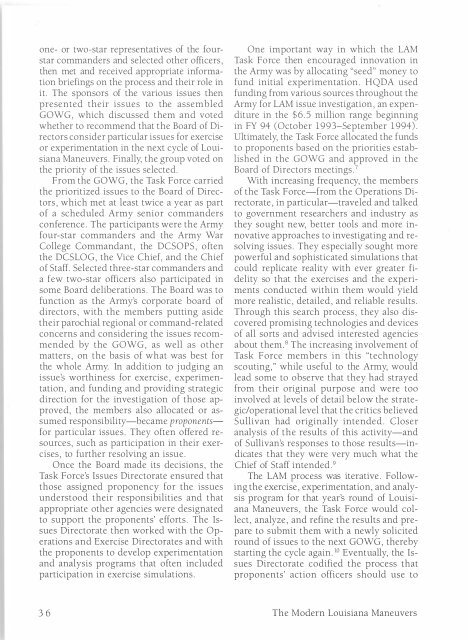The Modern Louisiana Maneuvers - US Army Center Of Military History
The Modern Louisiana Maneuvers - US Army Center Of Military History
The Modern Louisiana Maneuvers - US Army Center Of Military History
You also want an ePaper? Increase the reach of your titles
YUMPU automatically turns print PDFs into web optimized ePapers that Google loves.
one- or two-star representatives of the fourstar<br />
commanders and selected other officers,<br />
then met and received appropriate information<br />
briefings on the process and their role in<br />
it. <strong>The</strong> sponsors of the various issues then<br />
presented their issues to the assembled<br />
GOWG, which discussed them and voted<br />
whether to recommend that the Board of Directors<br />
consider particular issues for exercise<br />
or experimentation in the next cycle of <strong>Louisiana</strong><br />
<strong>Maneuvers</strong>. Finally, the group voted on<br />
the priority of the issues selected.<br />
From the GOWG, the Task Force carried<br />
the prioritized issues to the Board of Directors,<br />
which met at least twice a year as part<br />
of a scheduled <strong>Army</strong> senior commanders<br />
conference. <strong>The</strong> participants were the <strong>Army</strong><br />
four-star commanders and the <strong>Army</strong> War<br />
College Commandant, the DCSOPS, often<br />
the DCSLOG, the Vice Chief, and the Chief<br />
of Staff. Selected three-star commanders and<br />
a few two-star officers also participated in<br />
some Board deliberations. <strong>The</strong> Board was to<br />
function as the <strong>Army</strong>'s corporate board of<br />
directors , with the members putting aside<br />
their parochial regional or command-related<br />
concerns and considering the issues recommended<br />
by the GOWG, as well as other<br />
matters, on the basis of what was best for<br />
the whole <strong>Army</strong>. In addition to judging an<br />
issue's worthiness for exercise, experimentation,<br />
and funding and providing strategic<br />
direction for the investigation of those approved,<br />
the members also allocated or assumed<br />
responsibility-became proponentsfor<br />
particular issues. <strong>The</strong>y often offered resources,<br />
such as participation in their exercises,<br />
to further resolving an issue.<br />
Once the Board made its decisions, the<br />
Task Force's Issues Directorate ensured that<br />
those assigned proponency for the issues<br />
understood their responsibilities and that<br />
appropriate other agencies were designated<br />
to support the proponents' efforts. <strong>The</strong> Issues<br />
Directorate then worked with the Operations<br />
and Exercise Directorates and with<br />
the proponents to develop experimentation<br />
and analysis programs that often included<br />
participation in exercise simulations.<br />
36<br />
One important way in which the LAM<br />
Task Force then encouraged innovation in<br />
the <strong>Army</strong> was by allocating "seed" money to<br />
fund initial experimentation. HQDA used<br />
funding from various sources throughout the<br />
<strong>Army</strong> for LAM issue investigation, an expenditure<br />
in the $6.5 million range beginning<br />
in FY 94 (October 1993-September 1994).<br />
Ultimately, the Task Force allocated the funds<br />
to proponents based on the priorities established<br />
in the GOWG and approved in the<br />
Board of Directors meetings.7<br />
With increasing frequency, the members<br />
of the Task Force-from the Operations Directorate,<br />
in particular-traveled and talked<br />
to government researchers and industry as<br />
they sought new, better tools and more innovative<br />
approaches to investigating and resolving<br />
issues. <strong>The</strong>y especially sought more<br />
powerful and sophisticated simulations that<br />
could replicate reality with ever greater fidelity<br />
so that the exercises and the experiments<br />
conducted within them would yield<br />
more realistic, detailed, and reliable results.<br />
Through this search process, they also discovered<br />
promising technologies and devices<br />
of all sorts and advised interested agencies<br />
about them 8 <strong>The</strong> increasing involvement of<br />
Task Force members in this "technology<br />
scouting," while useful to the <strong>Army</strong>, would<br />
lead some to observe that they had strayed<br />
from their original purpose and were too<br />
involved at levels of detail below the strategic/operational<br />
level that the critics believed<br />
Sullivan had originally intended. Closer<br />
analysis of the results of this activity-and<br />
of Sullivan's responses to those results-indicates<br />
that they were very much what the<br />
Chief of Staff intended 9<br />
<strong>The</strong> LAM process was iterative. Following<br />
the exercise, experimentation, and analysis<br />
program for that year's round of <strong>Louisiana</strong><br />
<strong>Maneuvers</strong>, the Task Force would collect,<br />
analyze, and refine the results and prepare<br />
to submit them with a newly solicited<br />
round of issues to the next GOWG, thereby<br />
starting the cycle again. 10 Eventually, the Issues<br />
Directorate codified the process that<br />
proponents' action officers should use to<br />
<strong>The</strong> <strong>Modern</strong> <strong>Louisiana</strong> <strong>Maneuvers</strong>
















